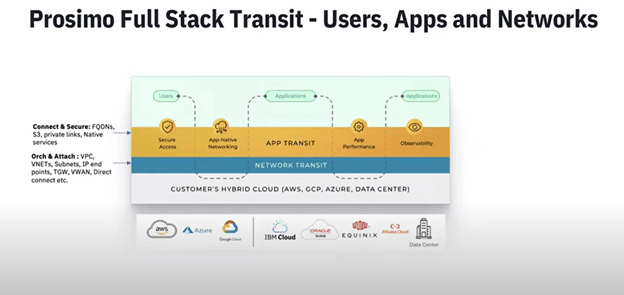I was at Cloud Field Day 15 and was very interested in the presentations by Prosimo. They are a three-year-old startup who have only been out of stealth for about 16 months. They have a platform that solves the complexity of multi-cloud networking. I am not much of a networking person, but I am an app person. So this presentation was really interesting to me.
Disclaimer: I got a nice swag box from Prosimo. But I wasn’t paid by them for this blog post, and they did not have an opportunity to review it.
Cloud Networking is complex
Right now, networking in the cloud is complex. Mani Ganesan (VP of Product) gave the presentation that set the stage for us (see video below). He told us that Prosimo is trying to get people to think about cloud networking differently.
He said when you think about cloud networking don’t just think VPC, routing, transit gateway etc. In other words, if you’re told to manage cloud networking you can’t just write some Terraform scripts and be done. You may start there, but quickly you’ll realize you have an application network as well, a network that understands PaaS and SaaS as well.
This is something I think about a lot. People with on-premises experience in networking are really needed in cloud networking operations. Networking is complex and critical to the success of an application, it’s not something an application developer will necessarily understand. But someone with 20 years of experience will understand, they just may need to come up to speed on the difference with cloud and other cloud native processes.
Problems Prosimo solves
Is the network configured correctly? Organizations may use 5-6 cloud regions; each will have hundreds of VPCs and VNets. How do you keep track of how they talk to each other, and do you know if they should they even be talking at all? How can you make sure no random VPCs join your network?
Cloud applications may be spread across multiple clouds, including the data center. Making them securely talk to each other at scale is one of the first cloud networking process you’ll encounter. Another common cloud networking problem is making sure application teams can talk securely to S3 buckets, RDS databases, or other cloud data points. How do you make sure that this is done privately and secure so no one else can see the communication?
Tool sprawl
Some people start with cloud networking by using the virtual tools they had on premises and build from there. Then others completely adopt the cloud native networking tools. But the problems come in when things start to scale.
According to Ganesan:
“Creating a coherent architecture built on al of these becomes a fundamental problem once you’re beyond a certain scale . . . it’s very hard to just put together 14 different tools and say hey, this is going to be my operational framework ops team will manage them.”.
Prosimo is trying to solve this problem by creating an architectural blueprint so any cloud can talk to any cloud. Prosimo’s tool also go into the application layer and helps network operators lay out which production apps should talk to which production databases.
Observability.
Observability is a core cloud native concept. In broad terms, it means when things go wrong, you are able to quickly observe where the problem is. Prosimo’s platform helps operators get that observability across all of their cloud networks.
Marketecture slides are your friends
So I need to pick at one thing Ganesan said. He referred to this slide as a marketecture slide – the only one he’d use.
This is a great slide! It explains how Prosimo flows, and who their partners are. In these days where we are explaining complex cloud concepts to operations folk with lots of experience, hug slides like this! And your marketers while you’re at it!
What I really think
I think if we’re expecting to scale in a multi-cloud environment, we’re going to need a couple of things. One is a platform like Prosimo to help break down the complexity problem. The other is for ops people to learn the words and challenges of the cloud native world, so we can help the next generation of ops from repeating our hard learned lessons.

